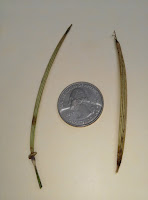In spring surprises . . ., posted on April 22, I lamented the total absence of California poppy blossoms or even buds in our front garden, yet "darling buds of May"* finally appeared and produced four lonely blossoms -- one at a time. Last Saturday, June 13, I photographed the laggard fifth. Somewhat darker than official state-flower standard, it had descended from the plants in a four-inch pot of mixed-color poppies we'd bought along with a pot of standard poppies at least four years ago at the Theodore Payne Foundation.
Meanwhile, the previous four blossoms had produced mature seedpods, and I started thinking about how best to ensure a good crop of poppies for 2016. It shouldn't be difficult, with the strong possibility of a rainy El Niño season ahead. I decided to pick two pods and scatter their seeds, and leave two to scatter their own seeds naturally. Here are the harvested two:
Maybe it's wishful thinking, but these pods seem to me to be longer than most, and so I included the quarter as a gauge of their size. Thomas Jefferson, our horticulturalist president, would surely approve, and the coin's 'heads' position invokes his blessing on the experiment. The pod on the left, BTW, is from the only one of 2015's new plants that has bloomed.
Finally, I used my thumb nail to open the pods onto the manila file folder where they had posed for their picture. The seeds rolled easily into the folder's central crease, which would have made it easy to pour them into a container.
Over dinner, Steve and I debated the merits of waiting for rain before scattering the seeds. He finally convinced me that the remaining pods wouldn't wait for rain before they opened. Feeling a bit like I was feeding the birds, I flapped my manila folder over a bare but well mulched patch where several poppy seedlings had appeared in February and March. If birds do eat any of the seeds, of course each one will be replanted along with a small portion of organic fertilizer.
Now to let nature take her course.
*Shakespeare's Sonnet #18 ("Shall I compare thee to a summer's day?")





